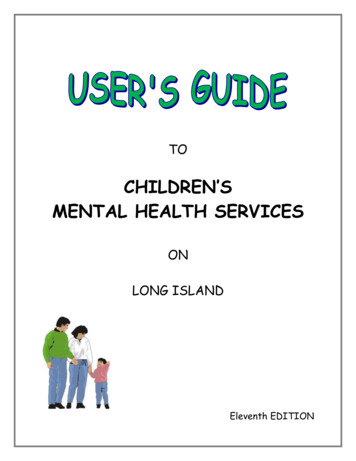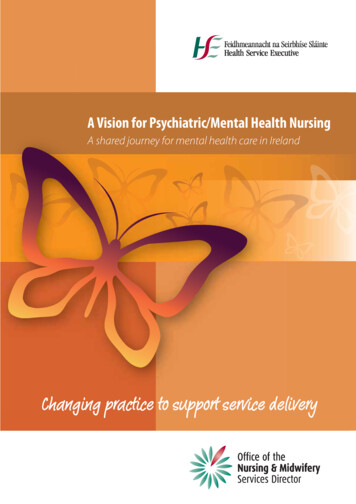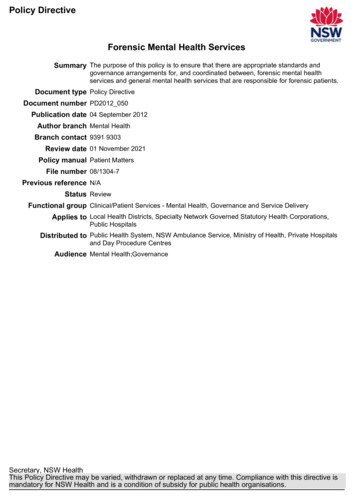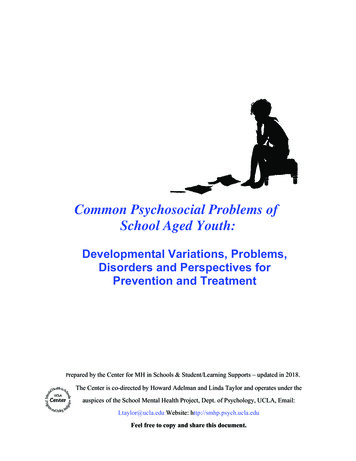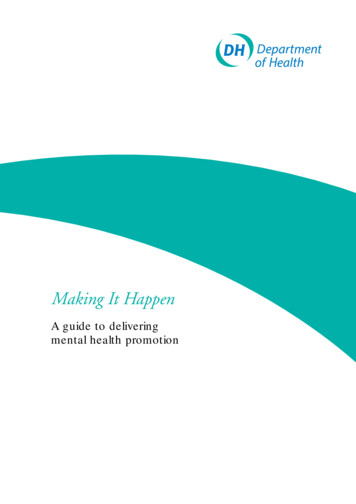
Transcription
Making It HappenA guide to deliveringmental health promotion
Making It HappenA guide to deliveringmental health promotionPurpose of this documentThis document is designed to provide information about mental healthpromotion and the evidence to support it to enable MSF Standard Oneleads and others to develop an effective implementation plan forStandard One of the National Service Framework for Mental Health.
ContentsAcknowledgement.3Foreword .5Summary .7Chapter OneIntroduction .151.1 Public mental health .161.2 Tackling discrimination: fostering a climate formental health promotion .171.3 Towards a strategic approach.221.4 Supporting a strategic approach .24Chapter TwoDefining mental health promotion.272.0 What is mental health promotion? .272.1 Mental health and well-being .282.2 Different perspectives .292.3 Mental health promotion at different levels .292.4 Risk and protective factors.30Chapter Three3.0 Introduction3.1 Case One3.2 Case Two3.3 Case Three3.43.53.63.73.8Making the case for mental health promotion.33.33Prevention and promotion.34Mental well-being and physical health .41Social capital: individuals, organisations,and communities under stress .46Case Four Local authorities and mental health promotion.50Case FivePrimary care and mental health promotion.54Case SixMental health services and mental health promotion .59Case Seven Mental health promotion and local information strategies.62Case Eight Mental health promotion in the workplace.64Chapter FourThe policy context .694.0 Introduction .694.1 Related NHS policy initiatives.724.2 International policy .741Making It Happen – A guide to delivering mental health promotion
ContentsChapter Five5.05.15.2Framework for developing a mental healthpromotion strategy .77Introduction .77Framework for a strategy.79Conclusion .91Chapter SixTypes of evidence available .936.0 Introduction .936.1 National Service Framework Grades of Evidence.946.2 Strengths and weaknesses of the evidence base .976.3 Questions to ask about data sources .97Chapter SevenExamples of evidence-based interventions .1017.0 Introduction .1017.1 Effective interventions.101Chapter EightApplying the evidence: The health and social impact ofinterventions .111Chapter NineApplying the evidence: community wide approaches .1159.0 Introduction .1159.1 Healthy Neighbourhoods .117Chapter Ten Evaluation .11910.0 Introduction .11910.1 Monitoring .12010.2 Indicators.120APPENDICESAppendix OneAppendix TwoAppendix ThreeAppendix FourAppendix FiveAppendix SixAppendix SevenMental health promotion models and frameworks .129Mapping mental health promotion: questionnaireand covering letter .133Using a problem tree.141Examples of good practice.147Citizenship and Community in Mental Healthprogramme plan.183Examples of evidence based practice pro-forma .191Feedback form .197REFERENCES.1992Making It Happen – A guide to delivering mental health promotion
AcknowledgementMaking It Happen outlines a process that will enable a wide range of groupsand agencies to meet their responsibilities in relation to Standard One of theNational Service Framework for Mental Health. It will also equip them tobegin some of the strategic development necessary to establish public mentalhealth.This document was produced by mentality, building on the wealth of workwhich has been undertaken in the field of mental health promotion over thepast five years. We would therefore like to thank all those who contributedtheir time and ideas to help us make it happen.We are grateful to all those who attended Making It Happen consultationworkshops in February and March 2001, to all those who completed feedbackforms with suggested improvements to the pilot copy and to all those whosubmitted projects as models of good practice.We are also grateful to all the advisory group members who commented onprevious drafts of the document and would particularly like to acknowledgecontributions from Jane Lethbridge, Woody Caan, Pratihba Datta, Ken Fox,Evelyn Krasner, Kate Phipps, Kate O’Hara, David Morris, Jude Stansfield andDave Tomson.Finally, we would like to thank the Department of Health’s Mental HealthPromotion Project Team for their support during this project. Making ItHappen is not the final word on mental health promotion. Evidence willcontinue to be gathered, programmes will continue to be implemented and wehope this document will continue to make mental health promotion happen.Dr Lynne FriedliChief Executive, mentality3Making It Happen – A guide to delivering mental health promotion
ForewordThe inclusion of Standard One in the National Service Framework for MentalHealth puts mental health promotion centre-stage. For the first time, healthand social services have a clear remit to promote mental health for all and toreduce the discrimination experienced by people with mental health problems.We have set clear targets to ensure that local services implement Standard Onebut we are clear that the Department’s role goes beyond exhortation. Deliverywill present a challenge and we have a clear responsibility to support localservices.Mental health promotion has a wide range of health and social benefits improved physical health, increased emotional resilience, greater socialinclusion and participation and higher productivity. It can also contribute tohealth improvement for people living with mental health problems and tochallenging discrimination and increasing understanding of mental healthissues.Mental health promotion also has a key role to play in service delivery. Itshould not be the sole responsibility of health promotion staff. People withmental health problems do have important needs for medical treatment and wemust improve the delivery of mental health services. However, medicaltreatment is only one part of the support they need. All staff working inservices have a responsibility to address the wider needs of the ‘whole person’:for example, for employment or other occupational activity, for suitablehousing and for their appropriate entitlement to benefits. Family, friends,schools, employers, faith communities and neighbourhoods all have animportant role to play, too, in enabling people with mental health problems toenjoy the same range of services and facilities within the community aseveryone else.Many of the factors which influence mental health lie outside health and socialcare, so mental health promotion is relevant to the implementation of a widerange of policy initiatives, including social inclusion, neighbourhood renewaland health at work. Effective mental health promotion depends on harnessingexpertise, resources and partnerships across all sectors and disciplines.5Making It Happen – A guide to delivering mental health promotion
ForewordI commend Making it Happen to you. It was developed in extensiveconsultation with a wide variety of stakeholders from the field. The guidance isintended to be helpful rather than prescriptive. I hope that it will providepractical support to help services develop their local strategies for mental healthpromotion.Jacqui SmithMinister of State for Health6Making It Happen – A guide to delivering mental health promotion
SummaryThis guidance provides a wide range of information to support people workingto promote mental health, with a specific focus on delivering Standard One ofthe National Service Framework for Mental Health.Work to promote mental health will be undertaken by agencies and individualsin many different sectors, with different backgrounds, roles and areas ofexpertise. These include users and carers, teachers, health visitors, public healthspecialists, community workers, primary health care staff, prison officers,advocates and many others. For this reason, people’s information needs willvary widely. We hope that this guide will serve as a resource, which people candip in and out of, making use of those sections which are most relevant totheir work. The following summary is designed to help you to find theinformation which will be useful to you.Chapter One - IntroductionChapter One introduces the guide and sets the scene for creating a positiveclimate for mental health promotion. It describes ‘public mental health’ andthe key elements of challenging stigma and discrimination. It outlines the fivemental health promotion targets which health authorities must meet by March2002 and the national, regional and local support available.Chapter Two - Defining mental health promotionChapter Two describes what is meant by mental health and mental healthpromotion and summarises risk and protective factors for mental healthproblems. This chapter may be most useful for people who want a briefoverview of mental health promotion.Chapter Three - Making the case for mental healthpromotionChapter Three is intended to help people make the case for investing in mentalhealth promotion. It summarises the benefits of mental health promotion andpresents different examples of how mental health promotion can contribute toimproved health and well-being. These include preventing mental healthproblems, improving physical health, strengthening communities, improvinginformation and reducing work related ill-health. This chapter also includes abrief summary of effective interventions in key settings, including home,schools and the workplace.7Making It Happen – A guide to delivering mental health promotion
SummaryThis chapter will be of special interest to practitioners who want todemonstrate the relevance of mental health promotion to a range ofstakeholders e.g. primary health care teams, mental health service providers,local authorities and employers.Chapter Four - The policy contextChapter Four describes local and national policy initiatives which are relevantto mental health promotion. It aims to make links with health, education,employment and regeneration initiatives which have the potential tocontribute to mental health promotion. Identifying policies with supportinggoals is an important part of building a local mental health promotion strategy.This chapter will be helpful for people working to develop strategic links acrossprofessional and sector boundaries.Chapter Five - Framework for developing a mental healthpromotion strategyChapter Five provides a framework for developing a mental health promotionstrategy and outlines some of the key tasks involved. It gives examples ofdifferent approaches and questions to consider when planning, mapping andselecting interventions.Chapter Six - Types of evidence availableChapter Six describes the types of evidence that are available and the strengthsand weaknesses of different grades of evidence. It includes questions to askabout sources of data, for example surveys. This chapter will be most useful topeople involved in planning evaluations or who want to critically assess theliterature on effectiveness. It may also be of interest to anyone who wants toengage with current debates about evidence of effectiveness and how thesedebates relate to mental health promotion.Chapter Seven - Examples of evidence-based interventionsChapter Seven provides a summary of interventions for which there isreasonably robust evidence of effectiveness. It is not a complete guide, butaims to give practitioners an indication of what works at different levels and ina range of different settings.Chapters Eight and Nine - Applying the evidenceThese chapters look at ways of applying what we know about what works.They aim to support practitioners in developing the evidence base and indesigning initiatives at a community and policy level. They may be of specialinterest to people with a background in community development or who areworking on neighbourhood or community wide initiatives.8Making It Happen – A guide to delivering mental health promotion
SummaryChapter Ten - EvaluationChapter Ten provides basic information on evaluation. It may be helpful forthose planning local activities, for example around World Mental Health Day,and can be photocopied and distributed separately.Appendix One - Mental health promotion models andframeworksThere are many different models and frameworks for promoting mental health.Appendix One gives two examples, drawn from the West Midlands RegionalFramework and the Scottish Development Centre’s Public Mental HealthProject.Appendix Two - Mapping mental health promotionAppendix Two includes an example of a questionnaire which can be used as abasis for mapping local mental health promotion activity.Appendix Three - Problem treesAppendix Three describes how to use a ‘problem tree’ to set aims andobjectives for a local strategy and gives four examples.Appendix Four - Examples of good practiceAppendix Four gives examples of good practice, outlining what each projectadds to what is already known about effectiveness and identifying areas forfuture research.Appendix Five - Citizenship and community in mentalhealthAppendix Five describes a citizenship programme which is designed to achievereal access to community opportunities for people with mental healthproblems.Appendices Six and Seven - FeedbackThese appendices include a pro-forma for further examples of good practiceand a feedback form to record your views on these guidelines.9Making It Happen – A guide to delivering mental health promotion
SummaryDelivering Standard OneThe Department of Health has developed a revised performance managementframework to monitor progress on implementation of all the NSF Standardsand the NHS Plan as it relates to mental health. The tables overleaf summariseStandard One and relevent key performance targets. The NSF requiredservices to develop a local mental health promotion strategy by April 2001. Inrecognition of the publication of Making It Happen in July 2001, a revisedperformance target of March 2002 has been set for services to develop andagree an evidence-based mental health promotion strategy based on local needsassessment.Standard One: Mental Health PromotionAimTo ensure health and social services promote mental health and reduce thediscrimination and social exclusion associated with mental health problems.Health and social services should: promote mental health for all, working with individuals and communities combat discrimination against individuals and groups with mental healthproblems, and promote their social inclusion.Meeting Standard One will require action across whole populations, as well asprogrammes for individuals at risk.Performance will be assessed nationally by improvements in the psychologicalhealth of the population, measured by the National Psychiatric Morbidity Surveyand by a reduction in suicide rates. At a local level health improvementprogrammes (HImPs) should include evidence of action to: combat discrimination against the social exclusion of people with mentalhealth problems promote mental health in schools, workplaces and neighbourhoods; forindividuals at risk; and for groups which are most vulnerable.10Making It Happen – A guide to delivering mental health promotion
SummaryStandard One: Performance TargetsBy March 2002, develop and agree evidence-based mental health promotionstrategy based on local needs assessment.By March 2002, build into local mental health promotion strategy action topromote mental health in specific settings, based on local needs.By March 2002, build into local mental health promotion strategy action to reducediscrimination.By March 2002, the written care plan for those on enhanced Care ProgrammeApproach (CPA) must show plans to secure suitable employment or otheroccupational activity, adequate housing and their appropriate entitlement towelfare benefits.By March 2002, implement strategy to promote employment of people withmental health problems within health & social services.Developing a mental health promotion strategy: achecklistThe following checklist outlines the key stages in developing a strategy andindicates the relevant sections of the guide. For each stage of the strategy, it ishelpful to consider:Levels e.g. individuals, community, structural/policy.Settings e.g. schools, workplaces, prisons, mental health services, home/earlyyears, primary care, residential homes, acute services and A&E, media,neighbourhoods.At risk and vulnerable groups e.g. people sleeping rough, people in prison, victimsof abuse or domestic violence, refugees, people with drug and alcohol problems,looked after children, black and minority ethnic groups, low income and excludedgroups.11Making It Happen – A guide to delivering mental health promotion
SummaryKey stages in developing a strategyAgreeing a vision and setting aims and objectivesDefining mental health promotion – Chapter TwoFramework for developing a strategy – Chapter FiveMental health promotion models and Frameworks – Appendix OneUsing a problem tree – Appendix ThreeMapping existing initiativesMapping existing initiatives – Chapter Five, Section 5.2Mapping questionnaire – Appendix TwoIdentifying key settings and target groupsMaking the case for investing in mental health promotion – Chapter ThreeRisk and protective factors – Chapter Two, Section 2.4Making the links with policy initiatives with supporting goalsThe policy context – Chapter FourCitizenship and community development – Appendix FiveIdentifying key stakeholders – consultation and gaining commitmentMaking the case for investing in mental health promotion – Chapter ThreeTackling discrimination – Chapter One, Section 1.2Selecting interventionsTypes of evidence available – Chapter SixExamples of evidence based interventions – Chapter SevenApplying the evidence base – Chapters Eight and NineFinding the evidence to support the approach takenExamples of evidence based interventions – Chapter SevenTypes of evidence available – Chapter SixEstablishing indicators of progressApplying the evidence base – Chapters Eight and NineExamples of good practice – Appendix FourBuilding in evaluationEvaluation – Chapter TenIdentifying staffing and resource implicationsLocal services will need to identify the staffing and resource implications ofimplementing their strategy12Making It Happen – A guide to delivering mental health promotion
SummaryMental health performance management processesMental Health National Service FrameworkSeptember 1999January 2000NHS PlanLocal Implementation Teams(LIT’S)April 2000Local Implementation Plan(LIP’S) Stage 1July 2000LIP Stage 2 Self AssessmentService Mapping 1September 2000October 2000December 2000March 2001April 2001Comprehensive Review ofMH ServicesSaFFs & LAPs 200203SaFFs & LAPs 200102NHS Plan ImplementationPlanRegional and National reportson LIP2 OutcomesReport on Service MappingConsultation on content andprocess of LIP3 self assessmentand service mappingSeptember 2001October 2001LIT Stage 3Self AssessmentApril 2002Service Mapping 213Making It Happen – A guide to delivering mental health promotion
Chapter OneIntroduction“How society works at every level influences the way people feel about themselves.And how people feel influences how well society functions.” (Public Mental HealthProject, Scottish Development Centre for Mental Health Services,1999)This guide aims to provide support for people working to promote mentalhealth and offers guidelines for the effective delivery of Standard One of theNational Service Framework for Mental Health (NSF). The aim of StandardOne is to ensure that health and social services promote mental health andreduce the discrimination and social exclusion associated with mental healthproblems. Health and social services should: Promote mental health for all, working with individuals andcommunities Combat discrimination against individuals and groups with mentalhealth problems, and promote their social inclusion.Many of the factors that influence mental health lie outside the remit of healthand social care. Effective mental health promotion depends on expertise,resources and partnerships across all sectors and disciplines. Mental healthpromotion is also relevant to the implementation of a wide range of policyinitiatives including social inclusion, neighbourhood renewal, communitystrategies and health at work. The new agenda for service delivery, includingthe modernisation of the NHS, outlined in the NHS Plan, and theimprovement of mental health services, will also benefit from applying theprinciples of mental health promotion.Although health authorities have the lead role in ensuring delivery of StandardOne, these guidelines are relevant to local authorities and to colleaguesworking in all sectors, including the voluntary sector, private sector and inprimary care, transport, housing, social services, education, the workplace andoccupational health.15Making It Happen – A guide to delivering mental health promotion
IntroductionThis guide:Defines mental health and mental health promotionMakes the case for investing in mental health promotionShows how mental health promotion fits in with other policy initiativesProvides a framework for developing local strategiesDescribes the types of evidence and their strengths and weaknessesGives examples of effective interventionsDescribes how to apply the evidenceGives information on evaluation1.1 Public mental healthStandard One of the National Service Framework presents a significantopportunity for further developing mental health promotion work. It comesat a time when there are many policy initiatives in the UK that could benefitfrom mental health promotion input. For those working at local level withrelatively scarce resources, it will be important to demonstrate the relevance ofmental health promotion to a wider public health agenda, with a focus onwhat mental health promotion can contribute to health improvement and thereduction of health inequalities.The requirement in the National Service Framework to ‘promote mental healthfor all’ provides a valuable opportunity to transform the terms of the debateabout mental health and to consider what the Scottish Development Centrefor Mental Health Services and others have called the ‘public mental health’.(Henderson and McCollam 2000; Friedli 1999) ‘Public mental health’ takes abroader view of mental health and provides a framework for looking at how tocreate a mentally healthy society. This involves looking beyond prevention, tothe relationship between mental well-being and physical health, and therelationship between mental health and behavioural problems, violence, childabuse, drug and alcohol abuse, health in the workplace and risk takingbehaviour such as smoking and unsafe sex. It also involves addressing themental health impact of policies, planning and implementation.Mental health promotion is arguably the most challenging area of the NSF anddelivering Standard One will involve a major change in the way most agencies,above all the NHS, will have to work. It will require a shared understandingand vision of what mental health promotion actually is, and what it can deliver– not just for those involved in mental health, but much more broadly. Thiswill entail:16Making It Happen – A guide to delivering mental health promotion
Introduction looking beyond prevention, to the social, economic and health benefitsof investing in mental health promotion a greater understanding of the values and strategic prioritiesunderpinning a broader public health agenda – notably institutionalisingpartnership, involving the community, regeneration, social inclusion andreducing inequalities – and their relationship to mental healthpromotion enhanced public health expertise in relation to risk and protective factorsfor mental health problems.Many agencies working in areas that have a direct impact on mental health, forexample social exclusion or regeneration, would not describe themselves asinvolved in mental health promotion. There is a need to address the problemof language and conceptual frameworks in relation to mental healthpromotion, so that a meaningful debate can take place across professional andsector boundaries. Involving communities and engaging with lay perceptionsof mental health could help to achieve this: the high priority given byresidents to friendliness, community spirit, security, feeling safe from crimeand proximity to friends and family indicate that communities attach a centralimportance to feelings of mental well-being. (Villaneau et al 2000, Russell andKilloran 2000)1.2 Tackling discrimination: fostering a climate for mentalhealth promotionThe discrimination faced by many people with mental health problems can beone of the most debilitating aspects of their daily lives. Challenging prejudicialattitudes is therefore an important goal in its own right, but it can also help tofoster a climate of public understanding which is more receptive to broadermental health promotion initiatives. Alongside work to change publicattitudes, we also have a responsibility to ensure that discrimination againstpeople with mental health problems is tackled through the effective applicationof the Disability Discrimination Act.Improving public understanding will also play an important role in reducingthe stigma attached to working in mental health services, which contributes tolow morale and may discourage people from seeing a career in mental health.17Making It Happen – A guide to delivering mental health promotion
Introduction1.2.1 Public attitudesThe emphasis in Standard One of the National Service Framework on stigmaand discrimination has led to a renewed interest in public attitudes to mentalhealth, media coverage of mental health issues and interventions which seek topromote greater acceptance and understanding of mental health problems.This area needs to be treated with some caution because there is a considerablediscrepancy between public attitudes, as expressed in surveys, public attitudesrevealed in more detailed, qualitative research, and public behaviour, asexperienced by service users and those delivering services.The most recent RSGB (Research Services Great Britain) omnibus surveycommissioned by the Department of Health shows greater acceptance by thepublic of people with mental health problems.The vast majority of people have a caring and sympathetic view and believethat virtually anyone can become mentally ill. Fewer than one in five peopleconsider it frightening to think of people with mental health problems living inresidential neighbourhoods, with nearly half disagreeing strongly with thestatement ‘I would not want to live next door to someone who had beenmentally ill’. Although the public still express concern over how muchresponsibility can be given to peo
their time and ideas to help us make it happen. We are grateful to all those who attended Making It Happenconsultation workshops in February and March 2001, to all those who completed feedback forms with suggested improvements to the pilot copy and to all





